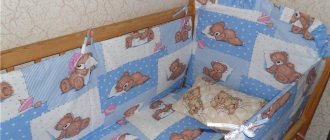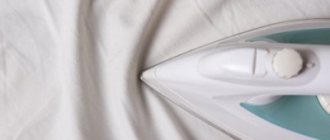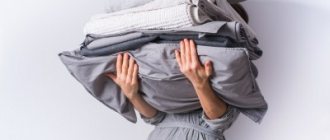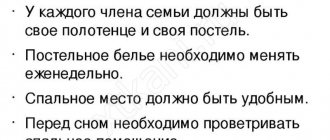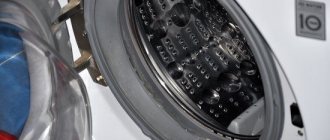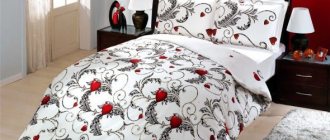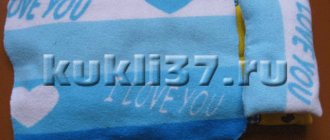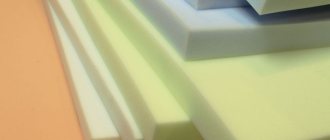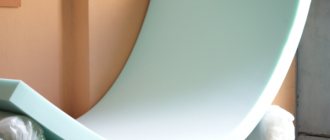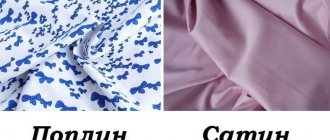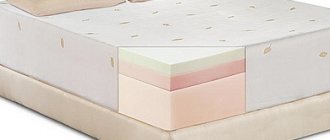When buyers choose bedding, they try not just to find a nice fabric, but to choose a set that can provide a comfortable feeling while sleeping. We propose to consider such a material as calico, how well it meets the requirements for bed linen, find out its positive and negative qualities and compare it with other linen fabrics, and examine the topic of the density of calico for bed linen, which is better.
Calico - what kind of fabric is it?
Calico is a material made from cotton fibers, woven using a classic plain weave.
Photo: Calico fabric, what it looks like up close
In some sources it is called paper canvas. “Coarse calico” translated from Turkic means “white”, although it can be unfinished (harsh) or bleached, with a printed pattern or plain-colored.
Initially, calico was used as a lining material, but from the moment they learned to bleach and soften it, it began to be successfully used for making linen and sewing underwear.
Fabric structure
In accordance with established standards adopted in our country, calico can only be called fabric with a completely natural composition, consisting exclusively of cotton fibers, i.e. made from 100% cotton.
In Pakistan, China and some other countries, when producing calico, it is allowed to add about 15-25% polyester fibers to the composition.
What is sewn from calico
The predominant use of calico is in bed linen. However, there are a number of other products for which this material is also suitable. Among them:
- Women's dresses, children's clothing, etc.
- Workwear, including military uniforms, suit sets and work coats for doctors, laboratory assistants, factory workers, etc. They are sewn using plain-dyed or bleached fabric.
- Lining in work overalls and jackets, providing good hygroscopicity, durability and pleasant tactile sensations.
- Home textiles, which in addition to bed linen include tablecloths, curtains, furniture covers and home clothing sets.
- Filtering and wiping cloths used for industrial and household needs.
- Liners for furniture upholstery and gaskets for sealing individual parts in the furniture and footwear industry.
What is the difference between calico and poplin, satin and percale?
All of the fabrics listed are completely natural or with a predominant content of cotton fibers. But they differ in some respects:
- Calico
has a plain weave of relatively thick threads. At the same time, the thickness of the weft and warp threads is absolutely the same. The fibers themselves have a slightly uneven thickness, which makes the surface feel a little textured, even slightly rough. Both sides of the material look the same. The fabric can withstand long-term use and is easy to wash even at medium temperatures. It does not wrinkle too much and retains the brightness of the color and clarity of the pattern well after numerous washes. Linen made from calico is a budget option with decent quality and complete naturalness. - Poplin
also has a plain weave, but the warp threads are thinner than the weft threads. Due to this, characteristic scars appear on the surface of the canvas. Similar to calico, it has good density, high strength, lends itself well to coloring, and does not wrinkle. It differs from calico with a smoother and softer surface. Poplin linen is a little more expensive than calico sets. - Satin
has a satin or satin weave in which one weft thread covers several warp threads. The pleasant shine of the front side and the dullness of the back are achieved through the use of double twisted thread. Compared to calico, it is a denser material, but not due to the thickness of the threads, but because of their number per 1 cm2. Comparable in strength to calico, but benefits due to external indicators. Satin is the most expensive of the fabrics under consideration. - Percale
, although it has a regular plain weave, is made from long-staple cotton, whose fibers are treated with a special adhesive composition - sizing. Due to this, percale exceeds the strength and durability of both calico and other cotton fabrics. It wrinkles more than calico, but is smoother and more tender to the touch. Percale can contain not only cotton, but also linen or polyester. In terms of price, it is cheaper than satin, but more expensive than poplin and calico. At the same time, calico is more hypoallergenic, since it is not subject to additional processing, while percale carries residual traces of glue treatment, which can cause skin reactions in some. In addition, due to the extremely high density of percale, its hygroscopicity and breathability are lower than that of calico, which can affect the quality of sleep, especially on hot nights.
All the fabrics under consideration have their pros and cons, but in general calico does not lose ground, since the ratio of price, durability, availability, external characteristics and environmental friendliness makes it indispensable for a wide range of consumers.
Process of obtaining textiles
The material needs to go through three stages of production to get to the shelves:
Stage 1 – spinning
This is the creation of long threads from raw materials (short fibers). This long twisted thread is called yarn. In ancient times, they spun by hand on wooden spindles. Now this is done by spinning factories. The raw materials that enter the factory are fibers pressed into bales.
On spinning machines they are stretched, twisted, and brought to perfection. Different machines work with chemical and natural fibers; these are two different technological processes. The finished yarn is wound onto bobbins and sent to the weaving factory.
Stage 2 – weaving
The process of weaving yarn. All work is done on weaving machines maintained by weavers. By the way, one weaver controls the operation of 40-50 automatic machines.
Along the matter there is a shared thread - the basis. It is strong and difficult to stretch. Weaving across it, a less strong thread passes through - the weft. It can be stretched. The sequence of their intersection determines the type of weaving. In linen form, they are intertwined in turn with each other. In satin weaving, the weft goes on top of 4 main ones at once, dives under the 5th and again covers the four. In the next row, the diving is shifted by 1 thread, forming a diagonal pattern.
Stage 3 – finishing
What calico density is best for bed linen?
If we add density to the naturalness, durability and beautiful appearance of the material, we get the main list of qualities that are valued in bed linen. The density of calico, like any linen fabric, is not in last place, since it provides both strength and external characteristics.
What density is calico?
Depending on the purpose of use, fabrics of varying densities are produced, g/m2:
- Sparse - about 80-90. Suitable for cleaning materials and some types of industrial filters.
- Light and comfortable - 110 and 120. When held up to the light, you can see the interlacing of threads, which in appearance resembles an embroidery canvas. Shrinks when washed. Due to the sparseness, the drawings do not look very good on it. For bed linen it is used in economy class. Not bad for making home clothes and textiles: bathrobes, pajamas, nightgowns, tablecloths, napkins.
- Lux – 125. It is distinguished by the use of thin threads and high weaving density. Due to this, the fabric turns out to be smoother, thinner, more durable - its qualities resemble percale.
- Full-woven - over 130. According to previously widespread GOST requirements, the density of calico should have been 142 g/m2. Ideal for bedding sets with high wear resistance and suitable not only for home use, but also withstands increased loads when used in kindergartens, medical institutions and hotels.
- Severe - from 145 to 160. Unbleached and untreated fabric. It is a rough, cream-colored fabric that is used in furniture and shoe production as a cushioning material.
What is denser calico, satin or poplin?
When comparing the density of calico with other cotton fabrics, which are also used for sewing bed linen, the following picture is obtained:
- The density of calico varies from 80 to 160 g/m2, but bed linen is made mainly from fabric with a density of 125 to 142 g/m2. With such a density of 1 cm2, it is about 45-65, with the exception of luxury calico, which has up to 140 threads per cm2.
- Satin is comparable in density to calico - from 120 to 145 g/m2. But, if in calico this is achieved due to the thickness of the fibers, then in satin - due to the number of threads, of which in 1 cm2 satin has from 120 to 170 pieces.
- Poplin density is about 100-120 g/m2. This is approximately 75-100 threads per 1 cm2.
Despite the overlapping density parameters, the difference in fabrics lies in the thickness of the threads and their number per unit area of the fabric, which significantly affects the characteristics of the materials.
Description
Calico is a fabric made from cotton. It is also included in satin, poplin, and chintz. These and other types of materials are similar to each other because they are classified as cotton products. They differ in the way the threads are interwoven, density and the presence of additional components in the composition.
When making calico, synthetic fibers are added to cotton. Very few of them are used, so the fabric is natural. The threads in it are intertwined crosswise. The material has a smooth surface and matte finish. The front and back sides are the same. Thanks to its natural composition, calico is safe for health and does not cause allergies. Therefore, it is widely used for sewing clothes for adults and children and for bed linen.
The material is practical. It is easy to wash and iron, and products made from it will last a long time. There are different types of calico, which differ in quality. It depends on the density of the material. The higher the density, the longer the fabric lasts. This indicator is the weight of the threads used to make a square meter of material.
Important! According to GOST, calico 145 g/sq.m is considered high quality. It is highly durable. At home, you can use medium-density fabric - 125 g/sq.m. If the product is made of fabric with a lower density, it will quickly become unusable.
Advantages and disadvantages
To make it more clear, in this section we will summarize all the pros and cons of calico.
Advantages:
- Eco-friendly, natural and hypoallergenic. Pure, minimally processed cotton provides these three qualities.
- Density, strength and wear resistance. Since calico of a sufficiently high density is used for sewing bed linen, it has good strength and can withstand about 300-400 washes.
- Moisture absorption and breathability of the material. Natural, untwisted fibers easily wick away excess moisture. Thick threads ensure the porosity of the fabric and its high breathability. This is a particularly valuable quality for people with excessive sweating.
- Wrinkle resistance. The fabric wrinkles quite a bit.
- Easy to care for. The material is undemanding in the choice of washing agents, can withstand different temperatures, washes well even at medium temperatures and is easy to iron.
- The choice of colors and their preservation during operation. The density of calico provides both the possibility of high-quality and uniform application of color for plain-dyed fabrics, and the application of a printed pattern while maintaining clear lines. Bleached calico also looks great.
- Price. Affordable pricing policy due to production technology. This allows a wide range of consumers to buy sets of linen made from natural materials with a wide range of positive qualities.
Flaws:
- Shrinkage. After washing, the fabric can shrink up to 7%. When choosing duvet covers, sheets and pillowcases, you need to take into account the possible change in their sizes after washing.
- Presentability. Linen made from calico is more often referred to as everyday linen. It looks neat, but not too sophisticated. Although for most buyers this is not a disadvantage.
- Texture. Not all consumers like the texture of the fabric, which occurs due to the fact that the threads have an uneven thickness. Therefore, people with sensitive skin should not purchase such underwear or put it in children's cribs. Although this same quality is also positive. Its advantage is that the fabric does not slip on the bed or move off it even during restless sleep.
Rules of care
Calico, the composition of which is exclusively natural, requires appropriate, albeit simple, care:
- High-quality and complete care is provided by basic washing rules.
- After washing, you need to dry the fabric.
- A rope outside or machine drying is suitable for this. The last step will be ironing.
Principle of care
Cotton material is easy to care for, for which it is appreciated by many housewives.
How to wash calico
The calico material is easy to wash. The procedure can be done in a washing machine or manually. Washing principle:
- For washing you need to use water with a temperature of 30 to 60 degrees.
- Before washing, turn the product inside out so that the pattern retains the color scheme.
- You can use any type of laundry detergent.
- To dry, you need to hang the product on a rope.
- Iron as usual.
You might be interested in this. Features of astragan: what is this fur made of, use for fur coats
Important! To make it easier to smooth out wrinkles, you need to start the procedure while the fabric is slightly damp.
Washing fabric
It is advisable to minimize the use of chlorine-containing products during the washing process. This will preserve the texture of the threads for a longer time.
Customer Reviews
Consumer opinions indicate that calico is an excellent material for making sheets, pillowcases and duvet covers. It perfectly absorbs moisture, ensures air circulation, creates warmth and comfort. Being 100% natural, it remains available to customers.
Therefore, consumers are willing to put up with some shortcomings, such as shrinkage and slight hardness and texture of the surface. Perhaps the look of calico is a little simple, but the fabric successfully performs its functions.
Which bedding is better: calico, satin, percale or poplin
When a buyer is faced with a choice of which fabric to choose bed linen from, several main factors need to be taken into account:
- Naturalness. Calico and satin fully meet this parameter. Poplin and percale can be either completely natural or mixed: poplin combines cotton with silk, wool or synthetics, and percale with linen or polyester fibers.
- Hypoallergenic. Depends on composition and processing. As a result, the most hypoallergenic are calico and satin.
- Softness and smoothness. Compared to other fabrics, calico is somewhat coarser, but there is a way out here too - purchase luxury linen from calico or use softening products.
- Hygroscopicity and breathability. Calico has the highest indicator of these values due to its naturalness, the use of untwisted threads in weaving and relative looseness, justified by the use of thick threads.
- Low creasing is typical for satin, calico and poplin, while percale is one of the few disadvantages.
- Appearance. Satin and percale look the most rich, while poplin and calico are a little simpler.
- Price. Calico has an affordable price, poplin is a little more expensive, then percale and the most expensive - satin.
These are the parameters that people pay attention to when choosing a bedding set in the first place. There is no definite answer what is better for the consumer, since for one the price will be the priority, for another - naturalness, and for the third - beauty.
History of appearance
The word “calico” comes from the Arabic name for dense, cotton fabric “bazz”, obtained by cross-weaving threads.
Merchants brought the material to Russia along with other goods from Asia. Starting from the 16th century, Kineshma weaving factories appeared, and Russian calico began to be in demand at fairs due to its affordable price.
Initially, the material served as a lining for caftans. Over time, it became softer and smoother, and whitening technology appeared. As a result, since the 18th century, the material began to be used in sewing underwear and bedding.
Today calico meets the needs of the army, medical and children's institutions. It is used to make light clothing, bed linen and home textiles.
How to soften calico bedding
If the only disadvantage of calico for you is its rigidity, then to solve this problem, use the following tips:
- wash clothes not with powders, but with gels, and also add rinse conditioner;
- do not over-dry the laundry so that it does not become “oaky”;
- use the steam mode while ironing, or start ironing while the fabric is still slightly damp;
- Use high temperatures when washing as little as possible, limiting yourself to programs with a temperature of 40 degrees.
Those who have chosen bedding made from calico will be able to fully appreciate its high quality characteristics. However, when choosing, take into account those few disadvantages - perhaps these factors are decisive for you.
